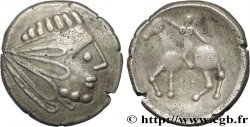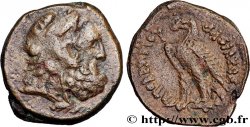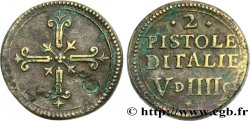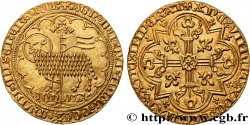Live auction - fjt_207260 - NOTAIRES DU XIXe SIECLE Notaires de Château-Thierry 1806
Чтобы принять участие в торгах, вы должны войти в систему и стать подтвержденным участником аукциона. Войдите, чтобы сделать ставку. Ваш аккаунт будет подтвержден в течение 48 часов. Не ждите до закрытия торгов, чтобы зарегистрироваться.Сделав ставку на данный товар, вы вступаете в юридическое соглашение на покупку выбранного товара и нажатием кнопки «Сделать ставку» подтверждаете принятие вами условий интернет-аукционов cgb.fr.
Ставка может бить сделана только в полном эквиваленте евро. Торги закроются согласно времени, указанному в описании товара, все ставки, сделанные после закрытия торгов, учитываться не будут. Не следует откладывать предложение вашей ставки до последнего момента, так как система может не успеть обработать вашу заявку, и ваша ставка не будет принята. Более детальную информацию вы найдёте здесь: FAQ по интернет-аукционам.
Все ставки победителей подлежат комиссии 18%.
Все ставки победителей подлежат комиссии 18%.
| Оценить : | 450 € |
| Цена : | Нет ставки |
| Максимальная предлагаемая цена : | Нет ставки |
| Конец торгов : | 25 June 2024 16:55:26 |
Тип Notaires de Château-Thierry
Дата: 1806
Металл: silver
Диаметр: 32,50 mm
Ориентация осей монеты: 12 h.
Век: cannelée
Редкость: R2
Ссылки в каталоге: :
Лицевая сторона
Аверс: легенда: MRS LES NOTRES DE L'ARROND. DE CHATEAU - THIERRY.
Аверс: описание: Armes royales couronnées sur main de justice et sceptre fleurdelisé croisés, entourées des colliers des Ordres et enveloppées du manteau royal. Signé Tiolier.
Обратная сторона
Реверс: легенда: LEX EST QUODCUMQUE NOTAMUS ; À L'EXERGUE : 1806.
Реверс: Описание: Le gnomon avec portrait impérial difformé.
Комментарий
On doit noter, et il est bien visible sur cet exemplaire, que la boule qui surmonte le gnomon portait un portrait de l’empereur qui a été difformé dans le coin. Ce détail aura généralement échappé aux contemporains comme il a échappé à Maître Lerouge, puisqu’il existe deux modèles du jeton pour la Restauration, avec le portrait de l’empereur et le coin modifié pour l’oblitérer.
On peut supposer que la première distribution de jetons se fit avec le revers “au portrait”, que cette incongruité - sous la Restauration - fut remarquée et que les distributions suivantes se firent avec des jetons frappés avec un coin apuré.
La devise "Lex est quodcumque notamus" est une création du père Ménestrier en 1686 pour les secrétaires du roi qui ne s'en sont jamais servi. L'invention fut reprise par les notaires de Paris puis ensuite par les notaires de Province.
It should be noted, and it is clearly visible on this example, that the ball surmounting the gnomon bore a portrait of the emperor that was deformed in the corner. This detail will generally have escaped contemporaries as it escaped Maître Lerouge, since there are two models of the token for the Restoration, with the portrait of the emperor and the die modified to obliterate it. We can assume that the first distribution of tokens was made with the reverse “with the portrait”, that this incongruity - under the Restoration - was noticed and that the following distributions were made with tokens struck with a purified die. The motto \\\"Lex est quodcumque notamus\\\" was a creation of Father Ménestrier in 1686 for the king's secretaries who never used it. The invention was taken up by the notaries of Paris and then by the notaries of the Province
On peut supposer que la première distribution de jetons se fit avec le revers “au portrait”, que cette incongruité - sous la Restauration - fut remarquée et que les distributions suivantes se firent avec des jetons frappés avec un coin apuré.
La devise "Lex est quodcumque notamus" est une création du père Ménestrier en 1686 pour les secrétaires du roi qui ne s'en sont jamais servi. L'invention fut reprise par les notaires de Paris puis ensuite par les notaires de Province.
It should be noted, and it is clearly visible on this example, that the ball surmounting the gnomon bore a portrait of the emperor that was deformed in the corner. This detail will generally have escaped contemporaries as it escaped Maître Lerouge, since there are two models of the token for the Restoration, with the portrait of the emperor and the die modified to obliterate it. We can assume that the first distribution of tokens was made with the reverse “with the portrait”, that this incongruity - under the Restoration - was noticed and that the following distributions were made with tokens struck with a purified die. The motto \\\"Lex est quodcumque notamus\\\" was a creation of Father Ménestrier in 1686 for the king's secretaries who never used it. The invention was taken up by the notaries of Paris and then by the notaries of the Province








 Cообщить об ошибке
Cообщить об ошибке Распечатать страницу
Распечатать страницу Отправить мой выбор
Отправить мой выбор Задать вопрос
Задать вопрос Consign / sell
Consign / sell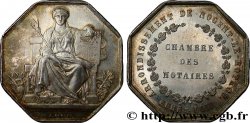
 Информация
Информация




